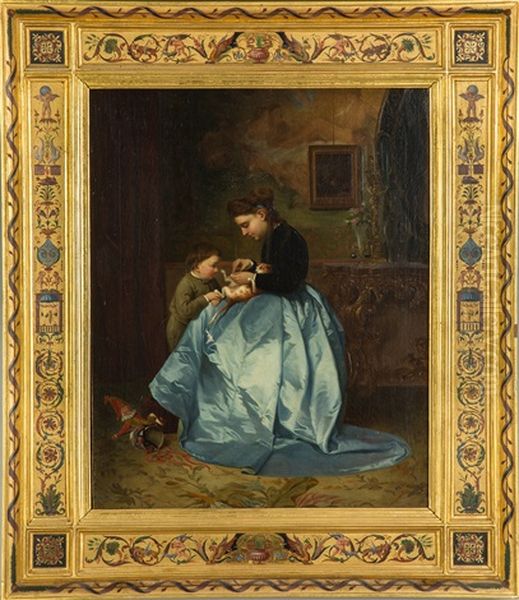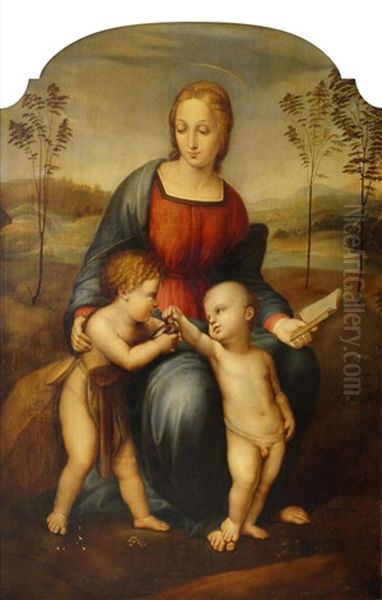Giuseppe Mazzolini (1806-1876) was an Italian painter who navigated the artistic currents of the 19th century, a period of significant transition and stylistic evolution in European art. While detailed biographical information about Mazzolini remains somewhat elusive, and his name is often confused with the prominent political figure Giuseppe Mazzini, his artistic output places him within the academic tradition prevalent during his lifetime. His works, characterized by a commitment to established artistic conventions, reflect the tastes and training of an era that still highly valued classical principles, meticulous execution, and narrative clarity.
The Artistic Landscape of Nineteenth-Century Italy
To understand Giuseppe Mazzolini's place in art history, it is essential to consider the broader artistic environment of 19th-century Italy. The century began under the strong influence of Neoclassicism, championed by figures like the sculptor Antonio Canova (1757-1822) and painters such as Andrea Appiani (1754-1817) and Vincenzo Camuccini (1771-1844). These artists emphasized order, clarity, idealized forms, and subjects drawn from classical antiquity or heroic historical moments. Art academies across Italy, from Milan and Venice to Rome and Naples, were the primary institutions for artistic training, reinforcing these Neoclassical ideals through rigorous instruction in drawing, anatomy, and the study of Old Masters.
As the century progressed, Romanticism began to challenge the cool rationality of Neoclassicism. Artists like Francesco Hayez (1791-1882), a dominant figure in Milan, embraced historical and literary themes imbued with emotion, patriotism, and drama, though often rendered with an academic polish. The "Purismo" movement, advocated by artists like Tommaso Minardi (1787-1871) and Luigi Mussini (1813-1888), sought a return to the perceived spiritual purity and simplicity of early Renaissance masters such as Fra Angelico or the pre-Raphael era. Concurrently, the academic tradition continued to thrive, adapting to incorporate elements of these newer sensibilities while maintaining its core tenets.
Mazzolini's Adherence to Academic Principles

Giuseppe Mazzolini's work, as indicated by his known pieces, aligns with this enduring academic tradition. The term "academic art" refers to the style of painting and sculpture produced under the influence of European academies of art. Key characteristics include a high degree of finish, an emphasis on accurate drawing and modeling, the use of chiaroscuro to create a sense of volume, and often, the depiction of historical, mythological, or religious subjects. Genre scenes, portraits, and allegorical compositions were also common.
Mazzolini's paintings reportedly featured a meticulous attention to detail and a skilled handling of light and shadow, hallmarks of academic training. The mention of decorative elements such as hand-painted angels, flowers, and floral patterns in some of his works suggests an inclination towards a refined, perhaps even sentimental, aesthetic that would have appealed to bourgeois patrons of the time. This decorative quality, combined with skilled execution, was a common feature in much 19th-century academic painting, which aimed for both technical proficiency and visual appeal.
Notable Works and Their Context
Among Mazzolini's documented works is "Papst Julius II" (Pope Julius II), dated 1842. This painting is described as a reinterpretation or copy of the famous portrait of Pope Julius II by the High Renaissance master Raphael Sanzio (1483-1520). Copying Old Masters was a fundamental part of academic training, allowing artists to study composition, technique, and color from revered predecessors. Mazzolini's choice to recreate Raphael's iconic image nearly three centuries later speaks to the enduring authority of Renaissance art within the academic curriculum. Raphael, alongside Michelangelo and Leonardo da Vinci, formed the triumvirate of High Renaissance genius whose works were considered paragons of artistic achievement.
Another painting attributed to Mazzolini is "Woman with Child and Kitten," a work from the 19th century. This title suggests a genre scene, a category of painting depicting everyday life that gained considerable popularity in the 19th century. Such scenes often carried sentimental or moralizing undertones, celebrating domestic virtues or capturing charming moments. The inclusion of a child and a kitten points towards a theme of innocence, domesticity, and perhaps the gentle, nurturing aspects of femininity, all popular subjects in the art of the period. This work, like "Pope Julius II," would have required strong skills in figure painting, composition, and the rendering of textures.

There is also mention of a work titled "Beatrice Cenci," which is suggested to be a copy or imitation of a painting attributed to the Baroque master Guido Reni (1575-1642) or his circle. The tragic story of Beatrice Cenci, a Roman noblewoman executed for patricide, was a popular Romantic theme, and the portrait, whether by Reni or an imitator, became an iconic image of tragic beauty and suffering. If Mazzolini indeed produced a version of this subject, it would further demonstrate his engagement with established artistic themes and his practice of studying and reinterpreting earlier masters. Reni himself was a highly influential figure, known for his classical grace and idealized figures, and his work was widely admired and copied.
The Roman Art Scene and Contemporaries
While specific details of Mazzolini's interactions within the art world are not extensively documented, he would have been active during a vibrant period in Italian art, particularly in centers like Rome. Rome, with its rich classical and Renaissance heritage, continued to be a magnet for artists from across Europe. The French Academy in Rome, located at the Villa Medici, played a significant role, bringing artists like Jean-Auguste-Dominique Ingres (1780-1867) and Horace Vernet (1789-1863) to the city, whose works and presence influenced the local scene.
Italian contemporaries of Mazzolini who worked within or alongside the academic tradition included painters like Pelagio Palagi (1775-1860), who worked in a style that blended Neoclassicism with Romantic elements, and Francesco Podesti (1800-1895), known for his large-scale historical and religious paintings. Later in Mazzolini's career, a new generation of artists, such as the Macchiaioli group, including Giovanni Fattori (1825-1908) and Silvestro Lega (1826-1895), began to challenge academic conventions with their emphasis on capturing light and everyday reality through "macchie" (patches or spots) of color, prefiguring Impressionism. However, academic art remained a powerful force throughout Mazzolini's lifetime, supported by institutions, patrons, and public taste.
Other notable Italian painters of the broader 19th-century milieu whose careers overlapped with Mazzolini's include Domenico Morelli (1823-1901), a leading figure in Neapolitan painting who moved from academicism towards a more Romantic and realistic style, and Federico Faruffini (1833-1869), whose work showed an interest in historical subjects and a vibrant use of color. The artistic environment was diverse, with ongoing debates about tradition versus innovation, the role of art in a changing society, and the definition of a modern Italian artistic identity, especially in the context of the Risorgimento, the movement for Italian unification.
Distinguishing Giuseppe Mazzolini the Painter
It is crucial to reiterate the distinction between Giuseppe Mazzolini the painter and his near-contemporary, Giuseppe Mazzini (1805-1872), the renowned Genoese patriot, philosopher, and politician who was a pivotal figure in the Risorgimento. The similarity in their names and overlapping lifespans can lead to confusion, but their fields of endeavor were entirely different. While Mazzini shaped the political landscape of Italy, Mazzolini contributed to its artistic heritage within the established framework of academic painting.
Furthermore, the surname Mazzolini is not unique in Italian art history. For instance, Ludovico Mazzolino (c. 1480 – c. 1528/1530) was a notable painter of the Ferrarese School during the Renaissance, known for his small-scale, richly colored, and often crowded narrative scenes, quite distinct in style and period from the 19th-century academic works of Giuseppe Mazzolini. Another artist, Giuseppe Mazzuoli (1644–1725), was a prominent Baroque sculptor from Siena, a student of Gian Lorenzo Bernini, known for works like "The Death of Adonis." These examples highlight the importance of careful attribution and contextualization in art historical studies.
Legacy and Assessment
Giuseppe Mazzolini appears to have been a competent and skilled practitioner of academic art in 19th-century Italy. His work, as exemplified by "Pope Julius II" and "Woman with Child and Kitten," demonstrates a commitment to the technical proficiency and thematic concerns characteristic of the academic tradition. He engaged with the legacy of Old Masters like Raphael and Guido Reni, a common and respected practice, while also producing genre scenes that appealed to contemporary tastes.
While perhaps not an innovator who radically altered the course of art history, Mazzolini's contributions form part of the rich tapestry of 19th-century Italian art. His paintings would have found an appreciative audience among those who valued the enduring principles of classical beauty, narrative clarity, and meticulous craftsmanship that the academies championed. In an era that saw the rise of Romanticism and, later, the stirrings of Realism and Impressionism, Mazzolini remained rooted in an academic approach, reflecting a significant and persistent stream within European art of his time. Further research and the discovery of more of his works would undoubtedly provide a fuller picture of his artistic career and his specific place within the Italian art scene of the 19th century. His oeuvre serves as a reminder of the diverse artistic expressions that coexisted and contributed to the cultural landscape of a nation undergoing profound transformation.